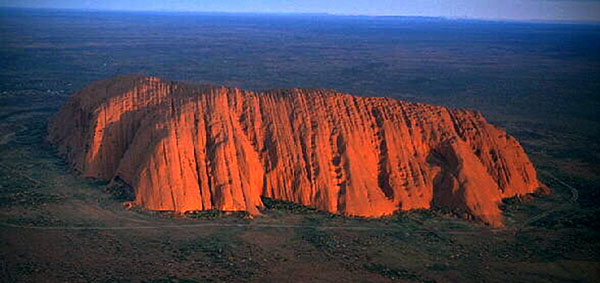By Marianne Bodi (Melbourne)
1. General Description
Uluru, the great sandstone monolith which rises 335 ms above the surrounding plain near Alice Springs in Central Australia has assumed great spiritual significance since times immemorial for desert Aborigines, particularly the local Pitjantjapjara and Yangkuntjatjara people.

The monolith is now part of the Uluru National Park which also includes Mount Olga (in the Oglas), six conglomerate monoliths and rock domes.
In 1985 the inalienable freehold title of Uluru was handed over (returned) to the local Aboriginal Community. The English name of Ayers Rock (named after a 19 century Governor of South Australia) is no longer used as an official name.
2. Creation Myths and Ancestral Links
According to tradition beliefs the outstanding topographical features of Uluru were created in the „Dreamtime“, the Creation Period, by various totemic beings in the shape of Giant Anthropomorphic goannas, serpents and other creatures. Each person in the group claims descent from these mythical totemic figures, and the ancestral locations are re-visited during ceremonies. These creation myths are depicted in the caves. The extraordinary paintings contain the iconography of an ancient oral culture – one of many – whose presence on the Australian continent is estimated to be around 40.000 years or more.
As in so many parts of the world, indigenous cultures of the continent have suffered irreparable losses as a result of white man’s conquest. There are very few groups left even in the remote areas who carry on their traditional lifestyle without adverse effects from powerful outside influences.
Some of the most promising forms of spiritual renewal are emanating from artists in Central Australia and elsewhere who are continuing to preserve the ancient iconography through modern media like acrylic paint with great brilliance.
3. Traditional Food of Aborigines in the Desert Areas around Uluru
Food gathering was very arduous in the harsh desert environment. The possession of water holes was essential for survival. Rain-water flow-off created pools around Uluru which also attracted animals.
A strong division of labour existed. Men went hunting and speared emus, kangaroos, wallabies and caught snakes and lizards.
Women and children gathered wild peaches, yelka nuts, wood grubbs, yams, honey ants, grass seeds, etc.
Traditional forms of hunting and food gathering are diminishing, and the skills associated with them are gradually lost.
4. The Significance of Uluru as the Quintessential Symbol of Aborignal Spirituality, Law and Rituals
While there is no proof of a single name denoting the monolith as such in traditional lore, the area around Uluru has for millenia been a major centre of „dreaming tracks“ which criss-cross Central Australia. According to the creation myths called „Tjukurrpa“ (dreamtime in Aboriginal English), giant ancestral totemic beings performed great deeds and thus formed the landscape around Uluru including hills, caves, springs, chasms, and other geographic features.
Important specific topographic locations on and around the Rock – some of which are sacred/secret – were named after ancestral heroes who created them, like Wiputa, Mutitjulu, Kalaya Tjuta, Walaritja, Kantju, Katjitikil, Taputji, etc. The deeds of these mythical creatures are also recorded and re-enacted in rituals (including ritual body decoration), epic story cycles, songs, dances, etc. by local groups. Traditionally participation in some of these rituals has been restricted to some members of the group (age, male, female); access to some of the rock paintings likewise.
For thousands of years spirituality (religion), lores and rules of Aboriginal life in Central Australia and elsewhere on the continent have been framed by these creation myths and by the central significance of physical features of the land. Not only are these landmarks/objects used for orientation and boundaries by various local groups, they also constitute essential cultural focal points. They are perceived as holding the essences of life, which, in turn, give birth to humans as subjects once again.
This bi-directional cycle of animistic transformation means that each generation and each individual must renew its self-objectification/identification through the land. The dynamic of this process enables people to orient themselves in the world. At the same time these mythical objects/landmarks serve also as socialising agents and unifying forces governing individual and collective life alike.
5. The Origin of the Name Uluru
To my knowledge, there is no traditional symbolic representation for Uluru itself. The monolith was named after a Yangkuntjatjara Aborigine, Paddy Uluru who began the movement by local indigenous groups to protect the sacred sites of the Rock. After many years of petitioning and struggle, he and his sons achieved the return of the land to the traditional custodians, and the Rock was passed to the Aboriginal Uluru – Kata Tjuta Land Trust in 1985. Since 1993 Uluru (the former Ayers Rock) and Kata Tjuta (the former Olgas) are part of the eponymous national park reflecting the Aboriginal heritage of the site and its cultural landscape values.
Thus Paddy Uluru, for decades a fugitive in his own land, caught between tribal law and white man’s law, gave his name and that of his family to this unique monument of human culture. The Park achieved World Heritage Listing in 1987.
References
Australian Geographic Society Encyclopaedia. Sydney 1988, Vol. I.
Isaacs, J. (Ed.): Australian Dreaming. 40.000 Years of Aboriginal History. Ure Smith Presse: Sydney 1988, Vol. I.
Layton, R.: An Aboriginal History of Uluru. Aboriginal Studies Press: Canberra 2001.
Horton, D (Ed.): The Encyclopaedia of Aboriginal Australia. Vol 2. Aboriginal Studies Press for the Institute of Aboriginal and Torres Strait Island Studies: Canberra 1994.
